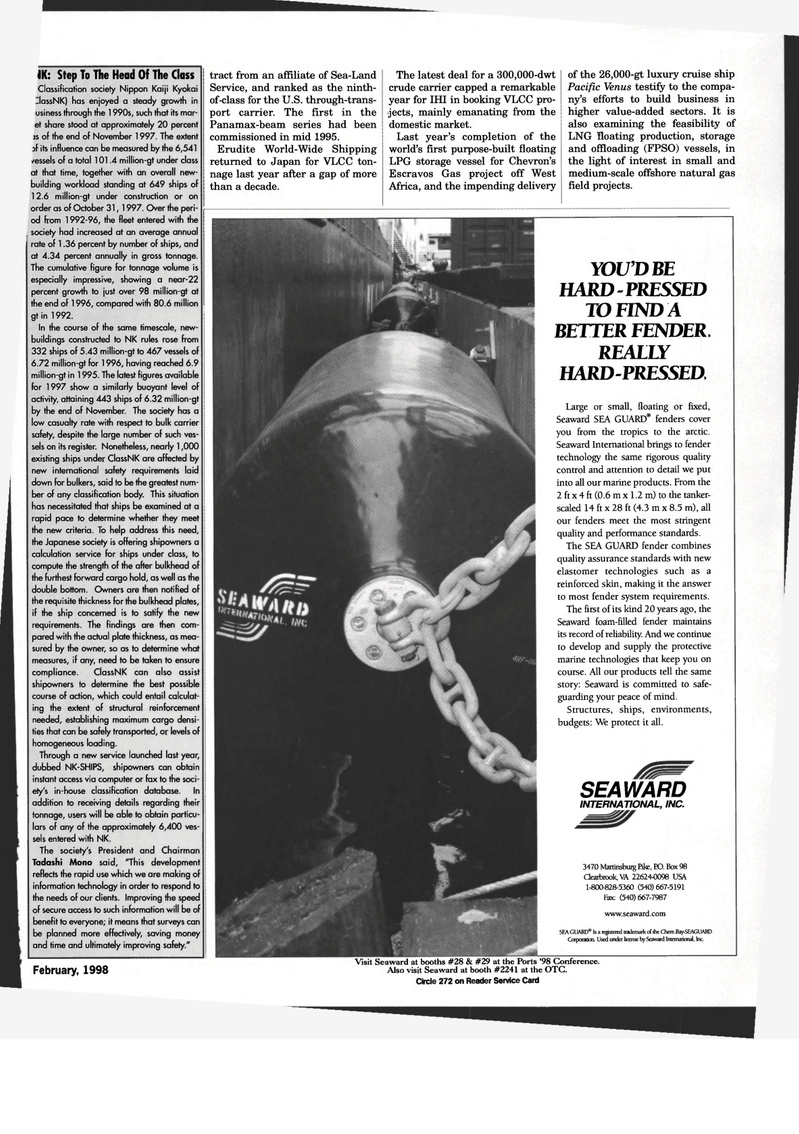
Page 67: of Maritime Reporter Magazine (February 1998)
Read this page in Pdf, Flash or Html5 edition of February 1998 Maritime Reporter Magazine
IK: Step To The Head Of The Class
Classification society Nippon Kaiji Kyokai
IlassNK) has enjoyed a steady growth in usiness through the 1990s, such that its mar- et share stood at approximately 20 percent is of the end of November 1997. The extent jf its influence can be measured by the 6,541 /essels of a total 101.4 million-gt under class at that time, together with an overall new- building workload standing at 649 ships of 12.6 million-gt under construction or on order as of October 31,1997. Over the peri- od from 1992-96, the fleet entered with the society had increased at an average annual rate of 1.36 percent by number of ships, and at 4.34 percent annually in gross tonnage.
The cumulative figure for tonnage volume is especially impressive, showing a near-22 percent growth to just over 98 million-gt at the end of 1996, compared with 80.6 million gt in 1992.
In the course of the same timescale, new- buildings constructed to NK rules rose from 332 ships of 5.43 million-gt to 467 vessels of 6.72 million-gt for 1996, having reached 6.9 million-gt in 1995. The latest figures available for 1997 show a similarly buoyant level of activity, attaining 443 ships of 6.32 million-gt by the end of November. The society has a low casualty rate with respect to bulk carrier safety, despite the large number of such ves- sels on its register. Nonetheless, nearly 1,000 existing ships under ClassNK are affected by new international safety requirements laid down for bulkers, said to be the greatest num- ber of any classification body. This situation has necessitated that ships be examined at a rapid pace to determine whether they meet the new criteria. To help address this need, the Japanese society is offering shipowners a calculation service for ships under class, to compute the strength of the after bulkhead of the furthest forward cargo hold, as well as the double bottom. Owners are then notified of the requisite thickness for the bulkhead plates, if the ship concerned is to satify the new requirements. The findings are then com- pared with the actual plate thickness, as mea- sured by the owner, so as to determine what measures, if any, need to be taken to ensure compliance. ClassNK can also assist shipowners to determine the best possible course of action, which could entail calculat- ing the extent of structural reinforcement needed, establishing maximum cargo densi- ties that can be safely transported, or levels of homogeneous loading.
Through a new service launched last year, dubbed NK-SHIPS, shipowners can obtain instant access via computer or fax to the soci- ety's in-house classification database. In addition to receiving details regarding their tonnage, users will be able to obtain particu- lars of any of the approximately 6,400 ves- sels entered with NK.
The society's President and Chairman
Tadashi Mono said, "This development reflects the rapid use which we are making of information technology in order to respond to the needs of our clients. Improving the speed of secure access to such information will be of benefit to everyone; it means that surveys can be planned more effectively, saving money and time and ultimately improving safety." tract from an affiliate of Sea-Land
Service, and ranked as the ninth- of-class for the U.S. through-trans- port carrier. The first in the
Panamax-beam series had been commissioned in mid 1995.
Erudite World-Wide Shipping returned to Japan for VLCC ton- nage last year after a gap of more than a decade.
The latest deal for a 300,000-dwt crude carrier capped a remarkable year for IHI in booking VLCC pro- jects, mainly emanating from the domestic market.
Last year's completion of the world's first purpose-built floating
LPG storage vessel for Chevron's
Escravos Gas project off West
Africa, and the impending delivery of the 26,000-gt luxury cruise ship
Pacific Venus testify to the compa- ny's efforts to build business in higher value-added sectors. It is also examining the feasibility of
LNG floating production, storage and offloading (FPSO) vessels, in the light of interest in small and medium-scale offshore natural gas field projects.
February, 1998 69
YOU'D BE
HARD PRESSED
TO FIND A
BETTER FENDER
REALLY
HARD-PRESSED.
Large or small, floating or fixed,
Seaward SEA GUARD® fenders cover you from the tropics to the arctic.
Seaward International brings to fender technology the same rigorous quality control and attention to detail we put into all our marine products. From the 2 ft x 4 ft (0.6 m x 1.2 m) to the tanker- scaled 14 ft x 28 ft (4.3 m x 8.5 m), all our fenders meet the most stringent quality and performance standards.
The SEA GUARD fender combines quality assurance standards with new elastomer technologies such as a reinforced skin, making it the answer to most fender system requirements.
The first of its kind 20 years ago, the
Seaward foam-filled fender maintains its record of reliability. And we continue to develop and supply the protective marine technologies that keep you on course. All our products tell the same story: Seaward is committed to safe- guarding your peace of mind.
Structures, ships, environments, budgets: We protect it all.
SEAWARD
INTERNATIONAL, INC. 3470 Martiiisbuig Pike, PO. Box 98
Clearbrook, VA 2262+0098 USA 1-800-828-5360 (540) 667-5191
Fax: (540)667-7987 www.seaward.com
SEA GUARD® Is a registered trademark of the Chem Ray-SEAGUAKD
Corporation. Used under license by Seaward International, Inc.
Visit Seaward at booths #28 & #29 at the Ports '98 Conference.
Also visit Seaward at booth #2241 at the OTC.
Circle 272 on Reader Service Card

 66
66

 68
68
